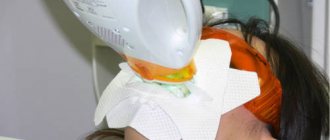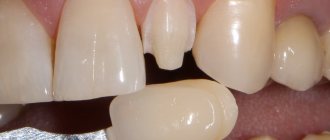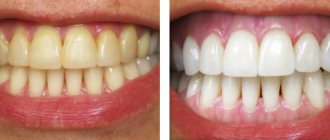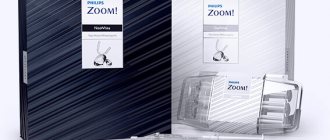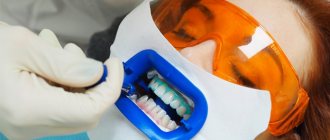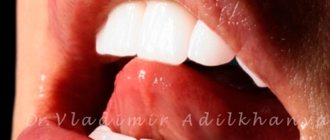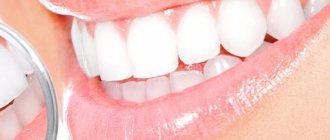According to surveys, the number of people in Russia who want to have a snow-white smile is constantly increasing, but the number of those who are disappointed with the results of the teeth whitening procedure has increased by 15%.
Why? Firstly, this is due to the independent, in most cases, incorrect choice of a teeth whitening system. Secondly, with the unpredictability of the result of any whitening procedure. It has been established that, depending on the initial color, teeth react differently to the whitening procedure. For example, a significant result is achieved when performing the procedure on enamel with a yellowish-brown tint. But gray tones do not change so noticeably even with intense exposure to drugs. According to doctors, the greatest disappointments await perfectionists who strive to get rid of even the slightest imperfections in their smile - if the original color was not too dark, then teeth whitening will only occur by a few (2-3) shades, and there will be no drastic changes after the procedure. And the darker the teeth were before, the more noticeable the difference will be after the aesthetic procedure. But whether such a radical leap is needed is a matter of personal aesthetic perception.
Teeth color, like eye color, is determined by genetic characteristics. Statistics indicate that the majority of Russian residents have a yellowish tint to their teeth. In the USA, the population generally has a grayish tone. And only a few can boast of whiteness close to ideal - it is created by a bluish-gray tint of enamel, which, as a rule, is found in the Negroid race.
In this article we will talk about teeth whitening systems depending on the result you want - to make your smile whiter than snow, whiten your teeth by more than 6 tones, or comply with the global trend of naturalness, lightening your teeth by a maximum of 2 tones.
Today, there are 16 shades of whiteness - and all of them are within normal limits. According to the European Vita scale, they are divided as follows: A - brown, B - yellow, C - gray, D - red. Each tone has its own intensity from 1 to 4. The norm for Europeans is color A3 - in this case the teeth are strong. The A1 shade indicates the fragility and thinness of the enamel.
What is photo teeth whitening?
Many people know the meaning of the Greek word “photos”, so they guess that light is involved in photobleaching. But what role does he play? Maybe this will be a discovery for some, but teeth are “translucent” with the usual halogen, ultraviolet or LED lamps. Can they change the color of teeth? Obviously not. Photobleaching involves the use of a special gel with 30–35% hydrogen peroxide, the effect of which is enhanced by light, which significantly speeds up the bleaching process.
Professional methods for lightening tooth enamel
This group of methods includes photo and laser whitening, Magic White and Beyond enamel lightening, as well as Air Flow teeth cleaning and others. Their main advantage is that they are performed under the supervision of a doctor, are performed efficiently and guarantee longer-lasting results. If you follow all the specialist’s recommendations after the procedure, the result can be maintained for several years.
Laser enamel lightening
This is a professional method that not only makes teeth whiter, but also strengthens them. During the procedure, their structure does not change, the acid-base balance remains unchanged. The result is very strong - on average, lightening occurs by eight shades or more, and it lasts for five years or more.
During the procedure, a special gel based on hydrogen peroxide or urea is applied to the tooth surface, which is exposed to laser radiation that activates the whitening system. The components of the gel begin to disintegrate, atomic oxygen is released, which, being a strong oxidizing agent, destroys color pigments that cause undesirable coloring. As a result, teeth become whiter, the enamel thickens by an average of 30-40%, and bacteria are also destroyed. Photos of teeth before and after laser whitening are shown below.
Teeth whitening Zoom
This is a progressive technique for changing the shade of tooth enamel, which is widely used throughout the world. A gel based on 25 percent hydrogen peroxide is applied to the teeth and treated with light from a special Zoom lamp. The peroxide decomposes, oxygen atoms are released, destroying the coloring pigments. Upon completion, the enamel becomes 8-12 shades lighter, as can be seen below in the photos before and after Zoom whitening. It is worth noting that, unlike laser, this method does not strengthen the enamel, but it is slightly cheaper in cost.
Enamel lightening Beyond Polus
During the procedure, the doctor applies a proprietary gel to the teeth and treats it with a special cold light lamp. The gel begins to release atomic oxygen, and a change in shade occurs. The photos before and after the Beyond Polus procedure show that the teeth become significantly lighter – by an average of 8-10 shades. Upon completion, they are coated with a fluorine-containing compound to strengthen the structure. The advantage of a cold light lamp is that burns to the soft tissues of the oral cavity are excluded, because the lamp practically does not emit ultraviolet and infrared radiation.
Magic White
In just 21 minutes, this method will make your teeth 4-8 shades lighter. It differs in that it uses 0.1% carbamide peroxide rather than hydrogen peroxide. The procedure is absolutely painless and does not cause increased sensitivity. In the photos below you can see the results before and after teeth whitening using the Magic White method.
The results last for several months, not years, but following a special white diet will help delay the next procedure. The cost of this method is significantly lower than those described.
Air Flow Cleaning
This technique does not involve the use of any oxidizing agents, as in previous methods. It serves to remove plaque and age spots from the surface of the teeth. To do this, they are exposed to a powerful jet of an abrasive agent (fine soda powder) with air.
Despite the fact that the result is up to four to six tones, as can be seen in the photo before and after Air Flow whitening, its undoubted advantage is the absence of increased sensitivity, as well as the pleasant smoothness of the surface of the teeth due to soft grinding with soda. In addition, this is the only method suitable for processing artificial inserts (veneers, fillings, crowns) and does not require a remineralization course.
How does photo teeth whitening work?
One photo-bleaching session takes about an hour. First, the dentist determines the color of the patient's teeth using a standardized VITA scale. He then places a buccal retractor, which allows for better access to the dental arches. A special protective composition is applied to the gums, and a whitening gel is applied to the teeth. Then both dental arches are irradiated with a lamp for 15 to 30 minutes. After this, the “spent” gel is washed off, and, if necessary, a new layer is applied to the enamel, and the procedure is repeated. If the patient is dissatisfied with the newly acquired color of the teeth or wants to enhance the result obtained, then he may be recommended to repeat the photo-whitening procedure or additionally use a home whitening system.
Cons of the procedure
Do not forget that chemical teeth whitening, reviews from some patients indicate this, may not end so rosy. The disadvantages of the method are:
- teeth become more sensitive and react sharply to cold and hot;
- there is a risk of gum damage;
- If you overexpose the drug, the enamel and dentin may be damaged.
Such complications most often occur if you decide to carry out the procedure yourself in this way. Professional teeth whitening, reviews and photos confirm this, usually gives good results and occurs without consequences.
Efficiency of photobleaching
You can usually whiten your teeth several shades. But the results of whitening, as well as its durability, regardless of the technique, are always individual. In many ways, the achieved effect depends on the natural shade of the teeth and the reasons for its change. For example, yellow teeth are more susceptible to lightening than gray teeth. A coffee or cigarette lover will be more likely to be satisfied with the results obtained, but someone with tetracycline teeth or fluorosis will probably waste their time and money. Therefore, if you are interested in the issue of effectiveness, then reviews from friends and colleagues about photo teeth whitening are unlikely to be useful to you. “I want teeth whiter than my girlfriend’s!” – You shouldn’t make such a request even to the best specialist. If you need a guaranteed result, it makes sense to think about installing lumineers, which quite effectively solve the problem of yellow teeth.
Advantages of the method
There are pros and cons to chemical teeth whitening. Let's start with the advantages that explain why many patients prefer this method:
- Efficiency. You can make the crowns lighter by 6-8 tones.
- You can achieve the desired result in one visit to the dentist.
- The result lasts for 2-3 years.
Chemical teeth whitening, reviews confirm this, is effective, but provided that there are no contraindications and the method is suitable for this particular patient.
Photo whitening and tooth sensitivity
Increased tooth sensitivity may occur as a result of exposure to chemicals and high temperatures. The solution to this problem is proper preparation for photobleaching. Before the procedure, the dentist must conduct an examination of the oral cavity in order to identify the presence of chips and cracks, caries, gum disease and other factors that may be a contraindication to whitening and must first be eliminated. In addition, before photo-whitening, professional hygiene and remotherapy are recommended, as well as the use of special pastes that eliminate hypersensitive teeth.
The Dangers of Chemical Bleaching
Many patients are afraid to use this method for obvious reasons:
- there is a risk of damaging tooth enamel;
- possible gum damage;
- there is a risk of irritation of the oral mucosa.
All these fears are not unfounded. If you get a chemical whitening procedure from an inexperienced specialist who has only practiced in treating caries, then the likelihood of complications is high. For real professionals, this procedure is already commonplace.
Doctors' advice after whitening
After the whitening procedure, the dentist must give the patient the following recommendations:
- Do not consume products containing coloring pigments for 3-5 days after the procedure. This includes beets, chocolate, red wine.
- To brush your teeth, use a brush with soft bristles.
- Avoid temperature changes when eating food. It is not recommended to eat food that is too hot or cold.
On the 3-4th day, tooth sensitivity normalizes, and all restrictions can be removed, but to maintain the resulting snow-white color for a long time it is necessary:
- use an ultrasonic brush to clean your teeth;
- rinse your mouth after every meal;
- use floss;
- Visit your dentist every six months for a preventive examination.
Following your doctor’s recommendations will help you maintain a snow-white smile for a long time.
Cost of whitening
Several factors influence the final price of chemical whitening:
- Cost of materials;
- doctor's skill;
- features of the procedure for a particular patient.
On average it turns out to be about 6-7 thousand for the Moscow region; in provincial cities it will be a little cheaper.
Whitening using trays will cost 1.5-2 thousand; toothpastes with this effect are affordable, but the effect of their use is minimal.
Contraindications for bleaching
No matter how much you would like to get a snow-white smile quickly and easily through chemical whitening, the technique is not suitable for everyone. It is necessary to take into account contraindications, and they are as follows:
- defects on teeth;
- caries;
- there are cracks and chips in the enamel;
- increased fragility of enamel;
- pacemaker. It is not allowed to carry out bleaching using light-sensitive preparations;
- acute gum disease;
- age up to 13-16 years;
- pregnancy;
- breastfeeding period.
Diseases of the teeth and gums are relative contraindications, and after treatment it is quite possible to whiten the enamel chemically.


